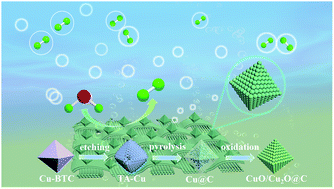Metal–organic framework derived carbon-encapsulated hollow CuO/Cu2O heterostructure heterohedron as an efficient electrocatalyst for hydrogen evolution reaction†
Abstract
It is of pivotal significance to probe highly efficient, cost-effective and low-cost catalysts for the hydrogen evolution reaction. Herein, a closely packed carbon-encapsulated CuO/Cu2O heterohedron with a heterojunction structure is reported that combines chemical etching and thermal oxidation processes. CuO/Cu2O@C-10 has remarkable catalytic activity for HER with an overpotential of 121 mV at a current density of 10 mA cm−2 and a Tafel slope of 81.58 mV dec−1, along with excellent stability in alkaline media under optimal conditions. Benefiting from CuO/Cu2O nanoparticles embedded in a carbon matrix, it forms a porous heterohedron structure by a close packing mode, owing to the unique CuO/Cu2O heterostructure with an ultrathin coated carbon layer and an interconnected conductive carbon network structure. These characteristics make a great contribution to the massive number of active interfacial sites, alleviating the aggregation of active substances, enhancing ion diffusion and the conductivity of the materials. This facile strategy sheds new light on a rational synthesis for a highly efficient hydrogen evolution catalyst with a heterostructure.



 Please wait while we load your content...
Please wait while we load your content...